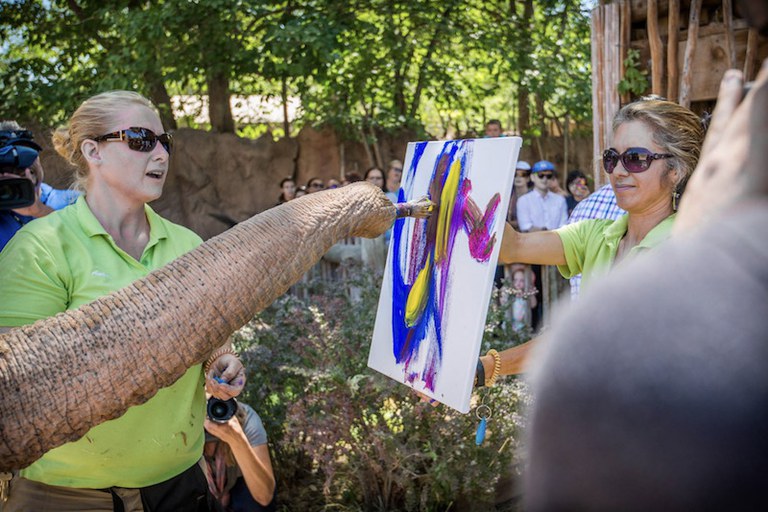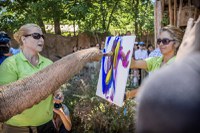What's Animal Enrichment?
Sept. 2, 2020 - If you’ve visited the ABQ BioPark Zoo, you may have heard animal caretakers talk about enrichment. But what is it exactly?
Bringing Out Wild Behaviors
We can’t bring the wild to the Zoo, but we strive to mimic it as best as possible. Enrichment at the ABQ BioPark is meant to promote natural behaviors that animals would display in the wild while at the same time providing them mental and physical stimulation. While keeping in mind the needs of the species, enrichment plans are also designed to meet the specific needs of each individual animal.
We always give animals choice of whether or not to participate in all enrichment activities. The end goal is to enhance overall animal welfare.
Enrichment Categories
There are six main types of animal enrichment:
- Food-based enrichment is meant to mimic what an animal would do in the wild for food.
- Structural enrichment is when objects are added to an enclosure to mimic an animal’s natural habitat.
- Olfactory enrichment is accomplished by adding odors to a habitat and can stimulate naturalistic behavior, enhance exploration and reduce inactivity.
- Cognitive enrichment involves presenting an animal with a challenging situation to solve, with the goal of mimicking natural ecological challenges they would face in the wild in order to acquire the resources, such as food and shelter, that they require to survive.
- Social enrichment can either involve housing a group of the same species or animals of different species together as they would naturally encounter each other in the wild. Social enrichment can encourage social behaviors that are seen in the wild, including feeding, foraging, defense, territoriality, reproduction and courtship.
- Human interaction such as training builds trust and increases an animal's cooperation during routine healthcare.
Examples of Enrichment at the ABQ BioPark

Enrichment can take many forms from balls and boxes inside a habitat, to scents, platforms and training sessions with keepers. The purpose of enrichment is to elicit natural behaviors in each animal while at the same time catering to each animal’s unique needs and preferences.
Platforms
Many of our animals have platforms in their habitats. This allows them to climb and provides them with more views around the Zoo and other habitats.
Feeding variations
- Feeding some of our predators whole carcasses helps them express natural hunting and feeding behaviors that they would in the wild. They also receive the natural nutrition that comes from eating bones, organs and meat.
- Our elephants and some primates have a feeding technology called Feed Pods in their habitats that encourages natural foraging behaviors. The ABQ BioPark was the first facility in the United States to implement this technology.
- Animal caretakers sometimes provide animals with flavored ice blocks that provide both enrichment as well as a cool treat on warm days.
Mirrors
Highly intellectual primates may have mirrors in their environment to stimulate them mentally.
Puzzles
Some animals, such as our great apes, are given food puzzles that they can choose to solve in order to find a treat. One example of a past food puzzle used at the zoo was the placement of peanut butter high on a wall in the orangutan habitat. In this example, the orangutans utilized long sticks as tools in order to get the peanut butter.
![]()
Balls
Encourage play and hunting behaviors.
Scents
Keepers often place a variety of scents inside a habitat to stimulate the animals’ olfactory senses. Keepers are familiar with the scents most preferred by each animal: perfumes, spices and other strong scents may be rubbed on objects within the habitat.
Human interaction
Animals also may engage with their keepers safely (in some cases through mesh barriers to protect human and animal). Human interaction could include training that encourages the animal to participate in routine healthcare exams. Animals are never forced to express a behavior; they are invited to participate and receive positive reinforcement (generally food) for offering desired behaviors.

